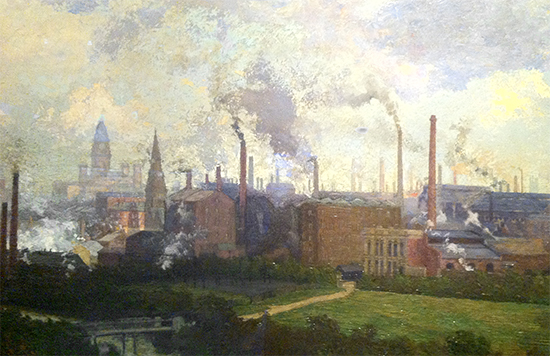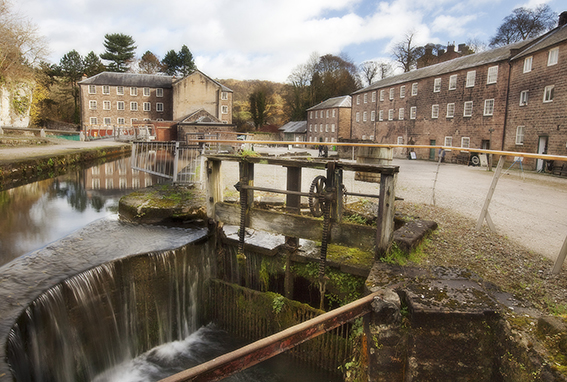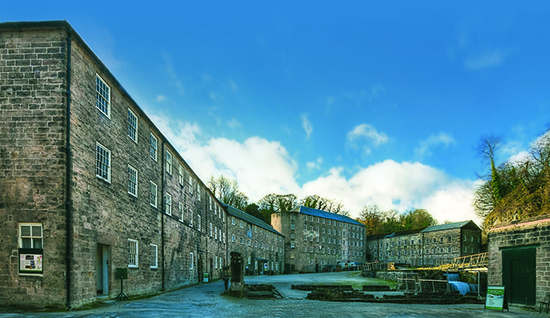I was probably not the only person to assume that the industrial revolution had started in Lancashire. But no – it was in Derbyshire, where the Derwent Valley mills revolutionised the cotton spinning industry by combining, on a large scale, machinery, workforce and water power – the birth of the factory system. Richard Arkwright’s mill at Cromford was the first to do so successfully and the “Arkwright system” became the blueprint for other early mills in England and beyond.
Given my interest in labour history and the socio-economic impacts of the textile industry, one of my first thoughts was: I wonder if Marx had anything to say about Arkwright? He did, and it wasn’t very complimentary. When talking about factory discipline in Das Kapital, Marx starts off by quoting Andrew Ure ‘s praise of Arkwright – “to devise and administer a successful code of factory discipline, suited to the necessities of factory diligence, was the Herculean enterprise, the noble achievement of Arkwright!” – only to then rubbish Arkwright’s character in a footnote: “Whoever knows the life history of Arkwright, will never dub the barber-genius ‘noble’. Of all the great inventors of the 18th century, he was incontestably the greatest thiever of other people’s inventions and the meanest fellow”. Controversy – what fun!
Marx would have based the “thiever” epithet on the fact that the patents Arkwright had taken out for his water spinning frame and carding engine were eventually overturned – the courts ruled that they were essentially copies of other people’s inventions.
-

-

However, Arkwright’s real genius was not in these inventions but in how he put them to use in his factory system. He appears a true capitalist pioneer – smart, innovative, happy to take risks, highly competitive, and with his eyes firmly on the bottom line. I was struck by the fact that Arkwright’s first partnership agreement (with two distant relatives) in 1768 commits them to becoming “joint adventurers and partners” in their quest for a patent and for improving and operating the invented machines. For it must have been quite an adventure, setting up that first spinning mill in Cromford. There was already some industry in the area – corn mills, lead mines, and grinding mills, all using of the available water power – but Arkwrights’s factory was to be much larger. And there weren’t enough people living nearby to build his mill and its machinery, never mind working in the mill once it was operating.
So what was work like at Cromford Mills? Until 1792, the factory operated 24 hours, after which night work was abolished. Workers worked 13 hour days (which included 1 hour for dinner), 6 days/week, from 6 AM to 7 PM in summer and from 7 AM to 8 PM in winter, with the night shift starting at 7/8 PM respectively. The factory bell would summon workers to work and factory gates closed at the start of the shift, so if you weren’t in on time you’d lose a day’s wages.
Occupational health & safety did not exist as a concept, but if you got sick you’d receive half pay and free medical assistance. Workers also had 8.5 days unpaid leave at important public holidays, which included 4 days for the “Cromford wakes”, the village’s big annual carnival/celebration.
Most workers were children from about age 7, preferred because of their small, nimble fingers and because they could be paid less than adults. The rest of the workforce were women; men were not employed in the spinning mills. But Arkwright wanted large families to move into the area to satisfy his increasing demand for labour, so he had to think of men’s employment as well. Solution: (i) men were employed in building the machinery and constructing new premises as the operation expanded; (ii) men found employment as knitters and weavers (at the time, these were men’s jobs) using the mill’s spun yarn, either working from home or in a workshop in the factory grounds.
Arkwright also built worker housing. His earliest terraces, built in 1776, still stand today. They were well-lit, high-quality houses, each with a garden plot attached. The top floors would accommodate the weaver’s rooms.
As you can see, these house were a far cry from the infamous back-to-back slums that proliferated in the cotton towns just a few decades later. More housing was added in subsequent years as the mills – and Cromford village – continued to grow.
Finally, Arkwright made what we would call today ‘corporate social responsibility’ or ‘philantropic’ investments. For example, he set up a school in Cromford which, according to the Manchester Mercury of February 1785, “already consists of two hundred children” who would go to school on sundays when they weren’t working. in 1790 he bought the Cromford Estate and built the Market Place including the Greyhound Public House.
Compared to what is known of mill practices and workers’ living conditions in Lancashire in the early decades of the 19th century, Arkwright’s regime appears comparatively benign. Many mills worked shifts of 14 hours or longer, with no break for dinner. Whereas Arkwright only accepted children aged 7 or older who had at least rudimentary reading and writing skills, other mills would employ children as young as 5 or 6, who were paid even less. An eyewitness in 1801 notes that the children leaving their shift at Cromford Mills looked “in general very healthy and many with fine, rosy complexions”. The unpaid holidays, half pay on sick days and medical attention offered by Arkwright were rare bonuses. It also helped that the mills were water-powered – the later, steam-powered mills tended to get hotter and were more polluting.
Another significant difference was in the housing. We know from many contemporary accounts, most famously Engels’ 1845 Condition of the Working Class in England, that the dank, dark, cramped, stinking, unsanitary slums – “cattle sheds for human beings” according to Engels – that housed the cotton workers were literally making people ill.
Or rather: more sick than they already were from working long hours in the mills. The development of factory legislation in the early 19th century indicates that working conditions in the rapidly expanding cotton industry must have gotten from bad to worse quite quickly. As early as 1802 the Apprentices Act was passed to tackle two key problems: the unhealthy working environment in the mills (e.g. dirty, too hot, badly ventilated), and the excessive hours worked by apprenticed children. (NB the concern was the children’s health; the fact that the children were working was not questioned per se). As ever, enforcement was the weak point: Robert Fitton’s book The Arkwrights – Spinners of Fortune quotes several accounts of factory owners ‘preparing’ for inspection visits by slowing the machine speed, lowering the temperature, dismissing sick and deformed workers, and cleaning up both the shopfloors and workforce. (To every factory auditor today, this procedure will sound familiar!) The 1819 Cotton Mills and Factories Act then extended the restrictions on child labour to all children: no children under 9 to be employed, with a maximum of 12 hours/day. Arkwright’s son, Richard Arkwright Junior, who continued the business after his father’s death in 1792, was among the few factory owners who did not oppose the Act.
So were the Arkwrights unusually enlightened and benign employers? They may well have been, and as owners and inventors of “the system” a certain paternalistic attitude would certainly appear natural. I would, however, argue that their comparatively better conditions could just as likely have been a function of economic necessity and competitive position in the market. In other words: they made good business sense at the time.
* When Arkwright built his first mills in Cromford he faced a significant shortage of locally-based labour. In order to encourage whole families to up sticks and settle in Cromford he had to offer something: Jobs for the whole family and good wages – as mentioned in Arkwright’s job adverts – would have been key pull factors.
* The other problem Arkwright faced was labour retention – people (particularly children) were simply not used to the idea of factory discipline. So it was a matter of sticks and carrots, and of being pragmatic: e.g. penalising lateness but offering a good enough job that would make workers want to stay put and succumb to the factory system; offering an official (unpaid) day off on a major public holiday when realistically no-one would turn up anyway. Also, by offering good housing conveniently close to the mill Arkwright increased the chances of workers staying in Cromford long-term, and turning up to work every day on time.
* Retaining his workforce for as long as possible was important for Arkwright not just in terms of productivity (i.e. not having to keep retraining new people) but also in terms of competition: He was determined to keep the monopoly of his “system” as long as possible, and paranoid about any competitors copying it. (His fears were well justified – more on that in another post). Therefore it was important to him that his workers were loyal – and if you prize loyalty you had better treat your staff reasonably well.
* The lack of immediate competition meant that Arkwright could afford the working conditions he offered whilst still making a large profit. As more and more cotton mills entered the market, competition became fierce; in such a situation reducing labour cost was (and is) always an easy way to maximise profits. So it’s not hard to imagine that later mill owners looked at Arkwright’s system and thought of ways of squeezing more money out of it.
* Importantly, later cotton barons had access to a constant oversupply of labour, in contrast to Arkwright. The 1834 Poor Law Amendment Act must have brought matters to a head, with masses of desperately poor people migrating to the cotton towns in search of work, given that the alternative – the workhouse – was not preferable. These people were extremely vulnerable to exploitation by mill owners and slum landlords, and exploited they were, including by being cheated out of their already meagre wages (as mentioned e.g. in Engels’ Condition of the Working Class). Reminds me a lot of the situation of Bangladeshi garment workers today.
I doubt that Arkwright could have imagined what monster he unleashed when he invented the factory system. He was a man of consequences – and that was to be the title for my Cromford-inspired work.
Note: My main sources for working conditions at Cromford Mills were: R.S Fitton: The Arkwrights – Spinners of Fortune (1989); and D Buxton/C Charlton: Cromford Revisited (2013)


















